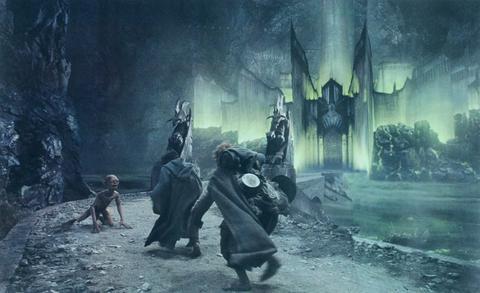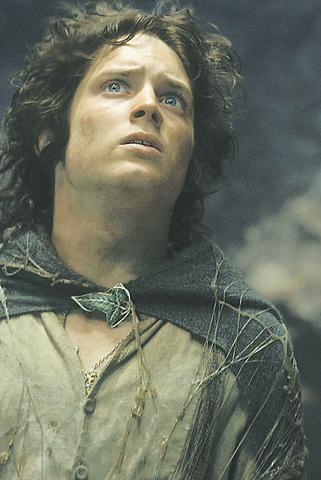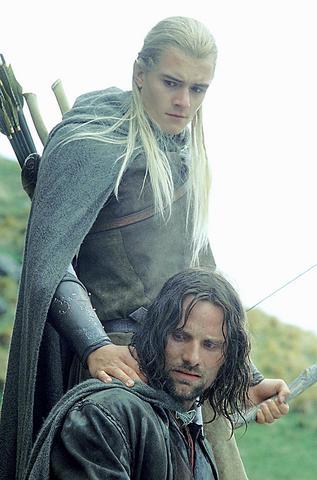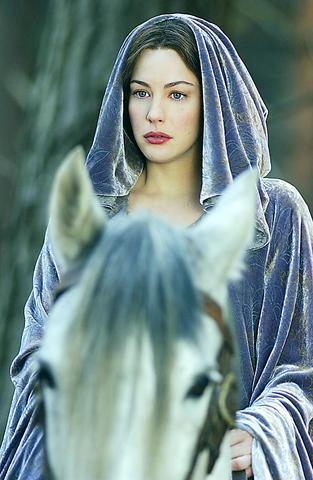IF anything can be called a cinematic event, the release of Lord of the Rings: The Return of the King is definitely that. So much has been expected of it, especially given the achievement of The Two Towers, that the third instalment is something of a disappointment. Many believe that Peter Jackson has saved the best for last, and in cinematic terms that is debatable, but in terms of storytelling, he will surely have disappointed aficionados of the book as he tries to draw in the many threads of the previous six hours of the trilogy.
That said, LOTR has brought the art of the cinematic trilogy to unprecedented heights and while it leaves plenty of room for lovers of the book to niggle over various acts of infidelity to J.R.R. Tolkien's grand vision, it has a massiveness of conception all its own that cannot be denied, and this will be the basis for its survival in cinematic history -- for ultimately the soul of Tolkien's life's work has not in any real sense survived the transition to celluloid.

This may seem a harsh judgment, but it must be accepted that the saga has been "Hollywoodized," stripped of its nuances and used as a vehicle to showcase the incredible technology that has become the real star of modern moviemaking. In this respect, the achievement of Andy Serkis as Gollum has proved truly remarkable, enlivening the long journey of Frodo and Sam into Mordor with some virtuoso schizophrenia. In other areas the technology has not been so effective.

But first to the story. Return of the King starts out with a recap of the history of the ring and how it came to be in the possession of Gollum. The fact that these little snippets from the history of the ring manage to provide adequate background for the story is a tribute to the editing skills of Jamie Selkirk. From there the film jumps to the fall of Isengard, though without any more scenes from Christopher Lee as Saruman, which is something of a pity.
From there we get into some serious Celtic revival stuff, which is the "Muster of Rohan" -- gorgeous and painstaking created costumes, lots of horses, beefy men with beards and a lovelorn and heart-rendingly beautiful Miranda Otto as Eowyn -- jump to Gondor and the "Madness of Denethor" and the much anticipated "Battle of Pelennor Fields," before a final gathering of the forces in front of the Black Gate.

Cut in-between these scenes of martial splendor is the journey of Frodo and Sam into the depths of Mordor, displaying a heroism of a different order. Elijah Wood and Sean Austin put in incredible performances in demanding roles, avoiding sentimentality by a hair. They are greatly aided by some brilliant visual effects that manage to make the lands of Mordor truly terrifying, although some of the final sequences around Mount Doom fall into a comic book excess that the trilogy had successfully avoided until this point. Brian Shore's generally complementary score also becomes rather intrusive towards the end, as the director seeks to pull any remaining heartstrings that the previous two-and-a-half hours have failed to pull already.

While many fans of the books were delighted by the degree of fidelity showed by director Peter Jackson in The Fellowship of the Ring, this diminished substantially in the second film, with the set piece battle of Helm's Deep greatly expanded from a mere 10 pages or so in the book to virtually one-third of the movie. The Battle of Pelennor Field, which spreads over four chapters or so, in which combat is interwoven with a development of personal relationships within the besieged city, is reduced pretty much to a single set-piece battle sequence. As magnificent as it is, it manages to be somewhat anticlimactic. It is after all just a diversion from the main action, which is taking place between Frodo, Sam and Gollum.
While this triangular relationship is brilliantly handled, the political relationship between Aragorn, Denethor and Farmair -- and the romantic relationship between Aragorn, Eowyn and Arwen -- is botched somewhat spectacularly, and this is at the heart of Return of the King's failure to move its audience. In the latter case it resorts to some of the worst cliches of Hollywood romance, with no attempt to re-create the chivalric ethos in which Tolkien's characters exist. In the former, the exposition required to make any sense of the relationship of Aragorn to Gondor and its family of high stewards would have probably required a whole separate instalment.
The huge scale of Return of the King tends to overwhelm individual characters, and despite the best efforts of John Nobel as Denethor and David Wenham as Faramir to inject some human drama into the Gondor sequences, this is no competition for the amazing costumes and computer graphics of the massed army standing at the gate.
This is not to say that Jackson does not plug away at the drama. He does, but with the exception of Aragorn's exhortation before the Black Gate -- when the ranks of Gondor and Rohan face off against insuperable odds and there is a speech worthy of Kenneth Branagh's St. Crispin's Day oration in Henry V -- it often seems rather stilted.
This is more than a pity, as Jackson -- having decided that the back story of Gordor is simply not possible to bring to the screen -- tries to see everything else in simplified psychological terms. What we end up with are cardboard cutouts. What is highlighted is simply the race against time, with the armies simply holding out to buy time for Frodo as he battles his way to Mount Doom. Here again we have Hollywoodization at work, with these simple structures taking the place of real story-telling.
It is also rather unsettling to see the repetition of certain screen effects, not least the "army of the dead," who sweep over the soldiers of Sauron in almost exactly the same way as the "army of Anubis" in The Mummy Returns, and their king is a ghostly graphic who seems to have escaped from Pirates of the Caribbean: Curse of the Black Pearl. No matter how well executed, these effects have little longevity and their reuse in LOTR diminishes it -- but this is probably because the series has given us unrealistic expectations of what it can achieve.
All the spectacle fails to make up for this glossing over of detail, which ultimately undermines it as a serious representation of the original work. The DVDs may go some way to remedying this, as they have considerable added footage, but that would be a subject for a separate review.

In Taiwan there are two economies: the shiny high tech export economy epitomized by Taiwan Semiconductor Manufacturing Co (TSMC, 台積電) and its outsized effect on global supply chains, and the domestic economy, driven by construction and powered by flows of gravel, sand and government contracts. The latter supports the former: we can have an economy without TSMC, but we can’t have one without construction. The labor shortage has heavily impacted public construction in Taiwan. For example, the first phase of the MRT Wanda Line in Taipei, originally slated for next year, has been pushed back to 2027. The government

July 22 to July 28 The Love River’s (愛河) four-decade run as the host of Kaohsiung’s annual dragon boat races came to an abrupt end in 1971 — the once pristine waterway had become too polluted. The 1970 event was infamous for the putrid stench permeating the air, exacerbated by contestants splashing water and sludge onto the shore and even the onlookers. The relocation of the festivities officially marked the “death” of the river, whose condition had rapidly deteriorated during the previous decade. The myriad factories upstream were only partly to blame; as Kaohsiung’s population boomed in the 1960s, all household

Allegations of corruption against three heavyweight politicians from the three major parties are big in the news now. On Wednesday, prosecutors indicted Hsinchu County Commissioner Yang Wen-ke (楊文科) of the Chinese Nationalist Party (KMT), a judgment is expected this week in the case involving Hsinchu Mayor Ann Kao (高虹安) of the Taiwan People’s Party (TPP) and former deputy premier and Taoyuan Mayor Cheng Wen-tsan (鄭文燦) of the Democratic Progressive Party (DPP) is being held incommunicado in prison. Unlike the other two cases, Cheng’s case has generated considerable speculation, rumors, suspicions and conspiracy theories from both the pan-blue and pan-green camps.

Stepping inside Waley Art (水谷藝術) in Taipei’s historic Wanhua District (萬華區) one leaves the motorcycle growl and air-conditioner purr of the street and enters a very different sonic realm. Speakers hiss, machines whir and objects chime from all five floors of the shophouse-turned- contemporary art gallery (including the basement). “It’s a bit of a metaphor, the stacking of gallery floors is like the layering of sounds,” observes Australian conceptual artist Samuel Beilby, whose audio installation HZ & Machinic Paragenesis occupies the ground floor of the gallery space. He’s not wrong. Put ‘em in a Box (我們把它都裝在一個盒子裡), which runs until Aug. 18, invites